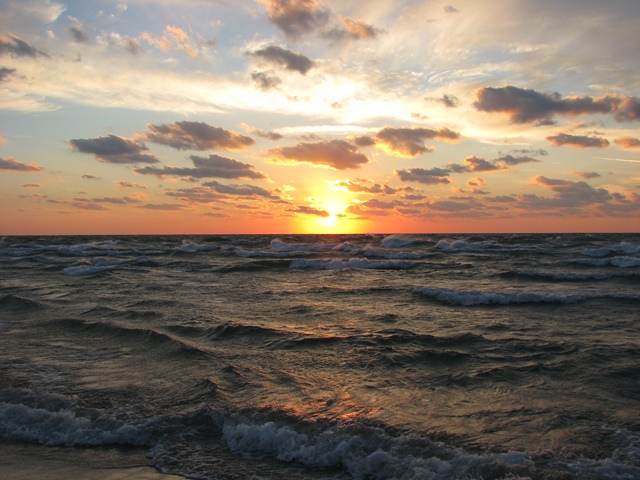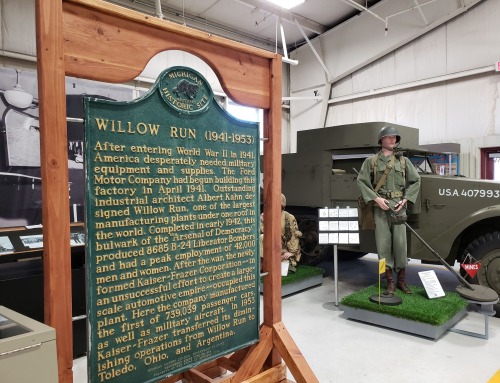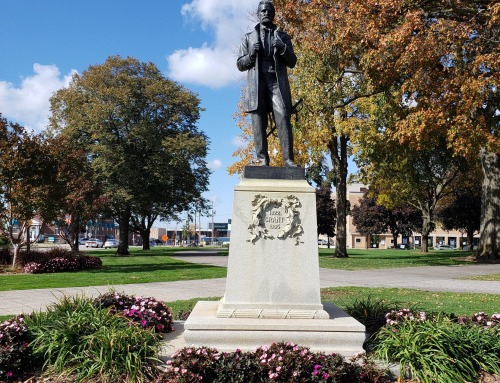Shipwrecks have been a danger to sailors, merchants and explorers since biblical times. Ships sailing on the Great Lakes are no exception. Over 6,000 have sunk to the bottom of the five lakes costing 30,000 people their lives. The Edmund Fitzgerald, which sank in 1971 may be the most famous; however, one of the first recorded shipwrecks in the Great Lakes remains one of the most mysterious.
Rene Robert Cavelier, Sieur de La Salle was a French explorer well known in the land formerly known as French Canada. Back in the late 1770s, he wanted to create a fur trade monopoly in the Great Lakes region by finding the Northwest Passage, which would be an all-water route from the Great Lakes to China and Japan. To do this, among other things, he decided he needed a masted ship to go where only canoes had gone before. He decided to build a large-scale, European-style sailing ship to complete his task. The 17th Century barque would be the first full-sized sailing ship on the Upper Great Lakes.
LaSalle knew that he would have to build his ship above the imposing Niagara Falls. If you have had the opportunity to view these majestic falls, you would easily understand LaSalle’s logic. Le Griffon, named for the mythical creature, was built in the wilderness, unlike most ships of the time that were built in the shipyards on the ocean.
There was much adversity for LaSalle and his workers during this time. The builders suffered from the intense cold and a lack of supplies. LaSalle had many admirers, but also many enemies, some who were envious and sought to ruin him. There was a constant threat of attack from the local tribes, especially the Seneca. There was attempted sabotage, attempted murder and even a plan to burn the ship. Luckily for LaSalle, a local Indian woman, whose name has been lost to history, foiled the plan. Once warned of this last attempted attack, Le Griffon set sail early to escape the dastardly plan.
In early August of 1679, Le Griffon was quickly launched near Cayuga Creek on the Niagara River, armed with seven cannons. LaSalle, Fr. Louis Hennepin, who wanted to convert the natives they would encounter, especially the Seneca, and a crew of 32 men were on board. Much of their course was uncharted, especially for sailing ships as opposed to canoe travel. Even after being launched, Le Griffon did not encounter smooth sailing. They arrived at the Detroit River on August 10 and entered the lake north of the river on August 12, the feast day of St. Claire of Assisi. Because of the holy day, the sailors named the lake after St. Claire. Continuing north, the crew needed to tow the ship up the rapids of the St. Clair River.
Once in Lake Huron, Le Griffon and her crew ran into more problems. They were becalmed at Saginaw Bay, unable to move because of a lack of wind. When they were finally able to escape the doldrums, they continued on their way, yet encountered more issues. On August 25, the crew ran into a bad storm, and were lucky to survive. On the third day they finally made it to Mackinac Island where Huron and Ottawa Indians enthusiastically greeted them in over 100 canoes.
Eight months before the voyage of Le Griffon, LaSalle had sent 15 men ahead with a large amount of goods to trade with the Natives for furs. When they arrived in the straits area, LaSalle learned that these men had deserted with a share of those goods, heading north. Two of these deserters were rumored to be up at Sault Sainte Marie. LaSalle sent his most trusted crew member, Henri de Tonty, and another six men to chase them down.
Based on the little that is known of him, Tonty could have his own story written. He was an esteemed Italian soldier and adventurer who had a hand blown off by a grenade years before in the Sicilian Wars. He bandaged the appendage himself and continued to lead his soldiers. The injury ended his military career, but Tonty continued his adventures. He had an iron claw made and strapped it to the stump on his arm and continued to live, work hard, and was competent with any weapon. Called “Iron Hand” from then on, he became LaSalle’s most faithful lieutenant.
LaSalle and his crew stayed in the straits area until September 12, but then had to leave without Tonty and the men who were going after the deserters. After leaving a message for his friend, LaSalle, and what was left of his crew, left for the Green Bay area. They landed on Rock Island and met up with friendly Pottawatomie natives, where they traded and loaded up Le Griffon with pelts.
When it came time to return back to Niagara, LaSalle was torn. He wanted to stay behind and explore Lake Michigan and try to find the mouth of the Mississippi River to claim the land around it for France. However, he did not trust his pilot, Lucas, and without Tonty to help him, he was unsure. Eventually his dream of exploring the Mississippi overcame his worry for his ship, and LaSalle decided to stay behind and send Lucas, his ship and a crew of six ahead to Niagara.
This skeleton crew was instructed to stop at Fort Michilimackinac to store most of the cargo where LaSalle planned to pick it up when he headed back east. The crew and Le Griffon left Green Bay on September 18, but were never seen or heard from again. The crew members, ship and furs all vanished. There was no clear consensus as to what happened, only rumors.
Some believe the ship was lost in a violent storm, which is possible as there was a storm reported in Lake Huron the day after Le Griffon left, at around the same time the ship would have been in those waters. Some believe it was set upon by fur traders who took the furs and sank the ship. Still others believe that Ottawa or Pottawatomie warriors murdered the crew and burned the ship. La Salle believed the pilot and crew sank the boat and stole the goods.
It would be seventy years before another sailing ship arrived on the Great Lakes.To this day, there is no conclusive evidence as to what happened to Le Griffon or where it went down, only legend. Some even claim to see it as a ghost ship.
Two years after the disappearance, LaSalle heard from a native interpreter that his captain and another Frenchman were brought to an Indian village by Sioux warriors. This witness reported that the ship and crew had survived a storm and the crew scuttled the ship and took a small cargo of furs, but were captured by the Sioux while traveling west. This, however, remains an unproven rumor.
Fortunately for him, not all was lost for LaSalle. Le Griffon led the way to modern shipping in the area, and he continued exploring the upper Midwest. He is now known for claiming much land for France, including the Mississippi watershed and the land between the Allegheny Mountains, the Rocky Mountains, and the northern part of the Great Lakes.
Yet, even to this day, the mystery of his ship’s disappearance intrigues historians and treasure-hunters alike. There have been over twenty claims of Le Griffon’s discovery, but most have been proven wrong or cannot be confirmed. In 2001, Steve Lebert believed he found the vessel in Northern Lake Michigan near Poverty Island. In 2014, Kevin Dykstra and Frederick J. Monroe claimed it was near Frankfurt. Neither of these claims could be proven. Most experts believe the most likely location is still the 1898 discovery of a wreckage by lightkeeper, Albert Cullis, on the western edge of Manitoulin Island in northern Lake Huron. This best fits with the history and what little evidence exists from the sinking.
Even after 340 years, the fate of the first sailing ship to enter the Great Lakes is a mystery. Le Griffon went down with only the 7 sailors knowing what its true fate was. Will we ever learn what happened or did all the information sink with the crew to be forever lost? Will it remain one of the many mysteries of history or will an adventurer continue to search for the missing clues? I for one would like to believe that someday the mystery will be solved.
Further information on the topic visit the Great Lakes Maritime Heritage Museum in Alpena or the Great Lakes Shipwreck Museum in Paradise.







Leave A Comment
You must be logged in to post a comment.